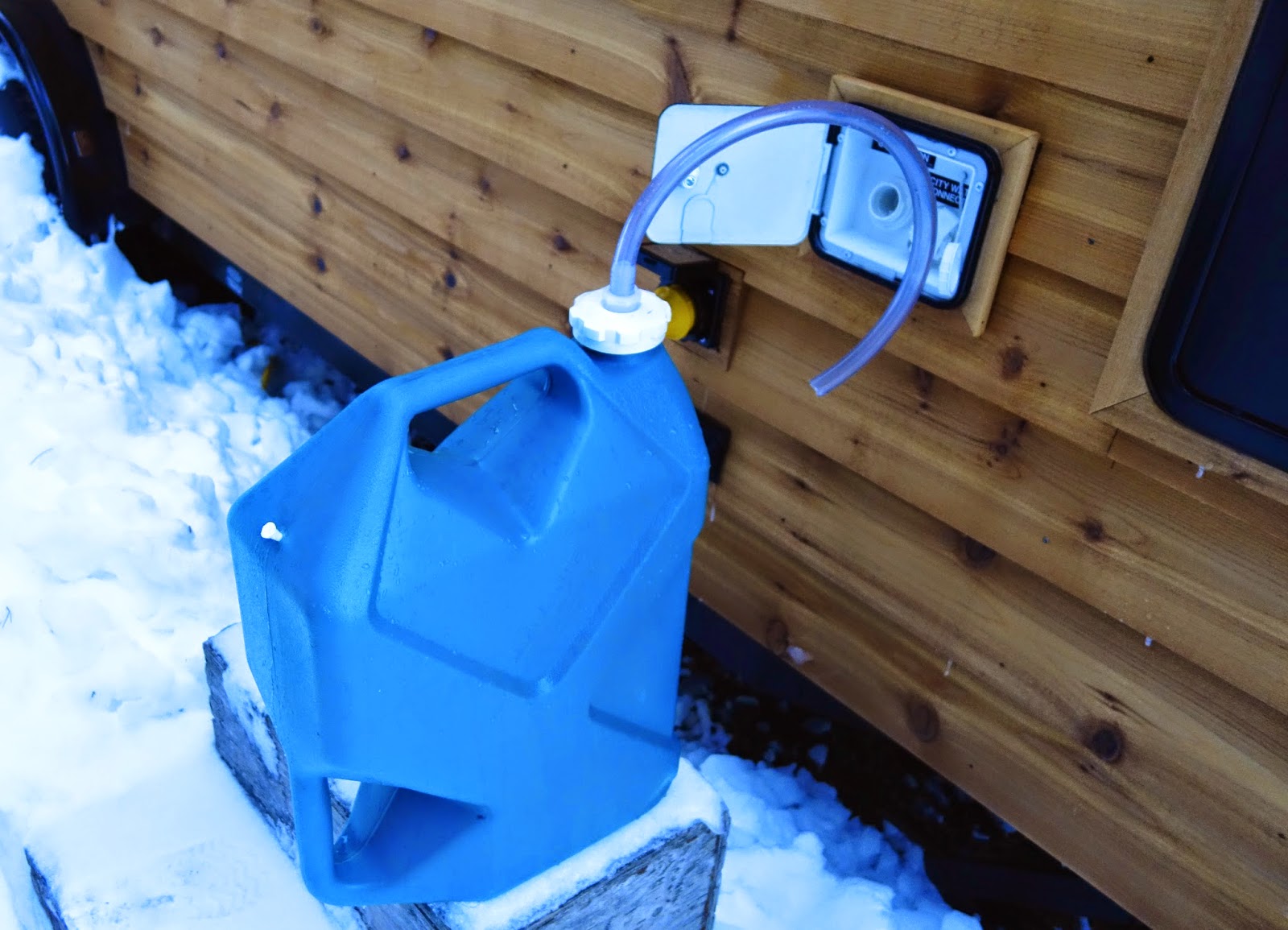Yes my house has plumbing, running water, hot water, all those things you'd expect in any house. The difference is how the water gets there for me. All of those things only have water to run and heat if there is water in my internal 26 gallon tank that hides under part of the kitchen counter. This could be filled easily and constantly by hooking it to a standard garden hose. And this would be great if I lived near a garden hose and if it wasn't way below freezing for much of the year. As it is, my tank only has water if I put it in there. So here's how my system works.
Those two jugs you see above, which have now actually been expanded to four just to make my trips more efficient, are the core of getting water into my tank. A friend has a well with great water about a mile up the road from me. So, when my tank is running low, or the weather is warm making the job a little easier, I load up my jugs and drive over. These jugs are pretty sturdy, but they have been abused a bit over their life so they do leak a bit around the vents if I fill them the whole way and then hit some bumps while driving back. So positioning them to hang over the floor board there is on purpose to keep my carpet dry.
This is where you add water to the tank from the outside of the house. The closed one is for the easy hose hook up if you have that option. The open one is what I use. You can also just see a little third hole, this is where the water starts to overflow back out of the tank if you try to keep putting more water in after it is already full.
As you can see below, sometimes a little water puddle will freeze right in the bottom of the trap but it is always easy to pop out with something like a screwdriver.
This is my hose set up that allows me to pour water right from my jugs and get around the uphill trap in the plumbing going into my water tank. The white part of the lid is the standard setup for these Reliance jugs and they have a threaded hole in the center for a spigot. I simply took that out and threaded in a hose fitting. I think this one is a 1 inch on the threaded side and goes to a 3/4 inch on the hose side. Then it was easy to just push about 18 inches of flexible hose onto that fitting. It seems to be an easier set up that trying to find a funnel with some kind of flexible end that can get around the trap.
Now all I have to do is shove that hose into the pipe until it's far enough in to be over the uphill part and drain into the tank instead of back outside and on to the ground.
And then stand on the nice little old mounting block, prop the jug on my knee, and wait for it to empty. Oh, and repeat this three more times if I am trying to go from an empty tank to a totally full one. None of which is really hard, but it does take some time, and kinda sucks when it's way below zero outside.
Inside, I also have a water jug like this that I use for things like filling glasses to drink from or any other little thing that only needs room temperature water. This keeps my (relatively high power use) water pump from needing to run as much. If you are building your own place with a water tank like this, I'd recommend putting the tank just high enough to gravity feed your plumping so you don't need a water pump at all. But this jug set up helps some with that in my house, and if I ever spill anything, it's positioned right over the sink where it shouldn't be a problem at all.
This amount of work does make one very conscious of your own water use, much more than I ever was when living just hooked up to an apparently unlimited water supply. I seem to average about 140 gallons of water a month here at my house. That covers all my cooking, dish and hair washing, watering plants, etc. I do usually shower at the gym and my toilet is a composting one, so it uses no water. This is about the same amount that the average American uses per day, so I know this system has made me much more careful with how I use water. Before, I could not have told you how many gallons I used a month, as I have no idea. But it was more that 140 I am sure.
In case you are interested in a similar set up for your tiny house or RV, following are links to some of the items I use and describe in this post. If you buy them through my link, you will be helping me pay the bills here in my tiny house!









